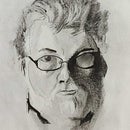Introduction: Transfiguration Bustle: Laser Cut Etched Leaf
This is an addition to our Transfiguration Bustle: Color device. The purpose of this instructable is to show how you can take our Infinity Fractal Leaf from Thingiverse and then use OpenScad followed by Inkscape to make a pdf that is suitable for cutting and etching on a Laser cutter. We have an 60W Epilog available to us so we will show what works for that system. Most Laser cutters have subtle changes to how the file needs to be constructed for them, but the process shown here should be easily tweaked for your laser cutter.
What you will need
- OpenScad
- Inkscape
- A Laser cutter
- Download of Infinity Fractal Leaf
Step 1: OpenScad Generates 2D Cut and Etch File
We really like OpenScad. We use it for almost anything we can. There are other tools that are comparable but we like it is open source and are programmers so it speaks to us.
OpenScad and the Customizer
Something like OpenScad is what is used in the Customizer on Thingiverse, I am not personally sure of the details. Customizer likes you to add comments that then become the sliders and checkboxes of the interface. Our leaf code starts with this information. For laser cutter we want to generate two svg files, one for the cut of the outer leaf shape and one for the viens.
First set the
doViens=0;
and at line 55 just before the petal module call add a
projection()
This will tell OpenScad to make a 2D object out of the 3D object by cutting through the leaf at z=0. Press F6 to create the 2D shape. Then in the file menu choose -> Export -> SVG give the file a name. I have the veins image the name leaf1Base.svg.
Change doViens=1 and doBase=0 in the file. Press F5 again and File->Export->SVG again giving it a different name. leaf1Viens.svg.
You now have two files for cutting and raster etch of the leaf and veins. Now on to Inkscape
Attachments
Step 2: Inkscape Creates the Pdf of Cut and Etch
- Startup inkscape
- File->Open then choose the leaf1Veins.svg
- Then File->Import then choose the leaf1Base.svg
- Since the base is imported last it should be on the top.
- Click the "none" fill on the palette, the little red x in the bottom left corner near the whites and grays.
- Shift-click on the Red (#FF0000) color in the palette.
- Click on the number nearest the stroke color, this will bring up the stroke/fill dialog on the right side of Inkscape.
- Choose "in" for the unit and set the stroke to 0.001, this seems like a very common thickness for laser cutting. If your laser cutter uses blue or green just shift click on that color.
- Now select the viens, we will add a gray scale gradient to make the etching deeper near the base and lighter toward the ends of the viens.
- Clicking on the viens should do the trick, because the "none" fill on the base.
- You should see the color and thickness change to black.
- Set stroke to none on the "stroke paint" tab in dialog on the right.
- Set black for the color of the fill using the palette at the bottom.
- Choose linear gradient
- Click the pencil button in the palette then change start and end point of the gradient so the dark parts of the veins are the thicker parts.
If your laser cutter will directly print from Inkscape you are done. Send to the printer. You can scale the image to the size you want. That can be done in the laser print manager as well.
The 60W Epilog does not have that so we just export a pdf.
File->Save As then choose leaf1.pdf for the filename.
Step 3: Conclusions
We use OpenScad and Inkscape as part of our workflow because we can always have them available. Using tools such as these enable people to create amazing projects.
Any questions or useful critique is always welcome.















